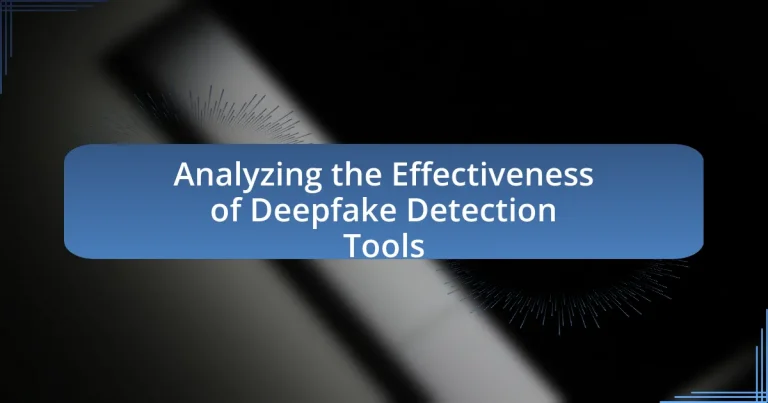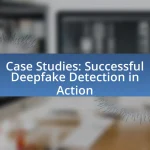Deepfake detection tools are software applications designed to identify manipulated media, particularly videos and audio, created using artificial intelligence. These tools employ machine learning algorithms and digital forensics to analyze inconsistencies in visual and auditory data, achieving accuracy rates exceeding 90% in controlled environments. The article explores the functioning of these tools, the technologies they utilize, their effectiveness in various scenarios, and the challenges they face, including the rapid advancement of deepfake technology. Additionally, it discusses the limitations of current detection methods, the role of user feedback, and future trends in enhancing detection capabilities.
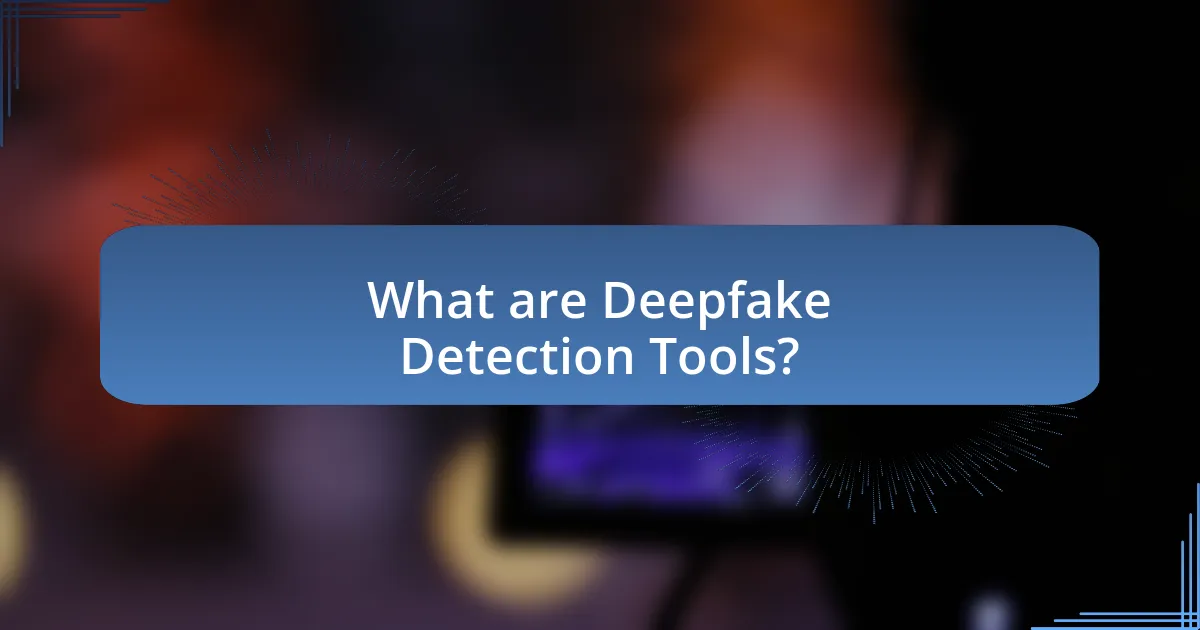
What are Deepfake Detection Tools?
Deepfake detection tools are software applications designed to identify manipulated media, particularly videos and audio, that use artificial intelligence to create realistic but false representations of individuals. These tools utilize various techniques, including machine learning algorithms and digital forensics, to analyze inconsistencies in visual and auditory data, such as facial movements, voice patterns, and pixel-level anomalies. Research indicates that the effectiveness of these tools varies, with some achieving accuracy rates exceeding 90% in controlled environments, as demonstrated in studies like “Deepfake Detection: A Survey” published in IEEE Access by authors including M. A. M. Alvi and A. A. A. Alzubaidi.
How do Deepfake Detection Tools function?
Deepfake detection tools function by utilizing advanced algorithms and machine learning techniques to analyze and identify inconsistencies in digital media. These tools examine various features such as facial movements, audio-visual synchronization, and pixel-level anomalies that may indicate manipulation. For instance, they often employ convolutional neural networks (CNNs) to detect subtle artifacts that are not easily perceivable to the human eye. Research has shown that these algorithms can achieve high accuracy rates, with some studies reporting detection rates exceeding 90% in controlled environments. This effectiveness is bolstered by continuous training on large datasets of both authentic and deepfake content, allowing the tools to adapt to evolving deepfake techniques.
What technologies are utilized in Deepfake Detection Tools?
Deepfake detection tools utilize a combination of machine learning algorithms, computer vision techniques, and audio analysis technologies. Machine learning algorithms, particularly deep learning models, are trained on large datasets of authentic and manipulated media to identify subtle inconsistencies in visual and auditory elements. Computer vision techniques analyze facial movements, expressions, and artifacts that may indicate manipulation, while audio analysis examines discrepancies in voice patterns and speech characteristics. Research has shown that these technologies can achieve high accuracy rates in distinguishing between real and fake content, with some models reporting over 90% accuracy in controlled environments.
How do these technologies differentiate between real and fake content?
Technologies differentiate between real and fake content primarily through the use of machine learning algorithms that analyze patterns and inconsistencies in media. These algorithms are trained on large datasets of authentic and manipulated content, enabling them to identify subtle discrepancies such as unnatural facial movements, irregular lighting, and audio mismatches. For instance, a study by Korshunov and Marcel (2018) demonstrated that deep learning models could achieve over 90% accuracy in detecting deepfakes by focusing on these specific features. Additionally, forensic analysis tools examine metadata and compression artifacts, which often differ between genuine and altered files, further enhancing detection capabilities.
What types of Deepfake Detection Tools are available?
Various types of deepfake detection tools are available, including machine learning-based tools, visual artifacts detection tools, and audio analysis tools. Machine learning-based tools utilize algorithms to identify inconsistencies in facial movements and expressions, while visual artifacts detection tools focus on identifying anomalies in pixel-level data that may indicate manipulation. Audio analysis tools examine discrepancies in voice patterns and speech characteristics to detect synthetic audio. These tools are essential in combating the growing prevalence of deepfakes, as evidenced by research indicating that machine learning models can achieve over 90% accuracy in detecting manipulated content under certain conditions.
What are the differences between software-based and hardware-based detection tools?
Software-based detection tools utilize algorithms and software applications to analyze digital content for signs of manipulation, while hardware-based detection tools rely on specialized physical devices to perform similar analyses. Software-based tools can be updated and improved through software patches, allowing for adaptability to new deepfake techniques, whereas hardware-based tools often require physical upgrades or replacements to enhance their capabilities. For instance, software-based tools like Deepware Scanner can analyze video frames for inconsistencies, while hardware-based solutions may involve dedicated processors designed for real-time analysis. The flexibility of software-based tools often leads to broader accessibility and lower costs compared to the typically higher investment required for hardware-based solutions.
How do machine learning models enhance detection capabilities?
Machine learning models enhance detection capabilities by utilizing algorithms that can identify patterns and anomalies in data more effectively than traditional methods. These models are trained on large datasets, allowing them to learn the subtle differences between genuine and manipulated content, such as deepfakes. For instance, a study published in the journal “Nature” demonstrated that deep learning techniques could achieve over 90% accuracy in detecting deepfake videos by analyzing facial movements and inconsistencies in audio-visual synchronization. This high level of accuracy is due to the models’ ability to process vast amounts of information and adapt to new types of manipulations, thereby improving their detection performance over time.
What challenges do Deepfake Detection Tools face?
Deepfake detection tools face significant challenges, primarily due to the rapid advancement of deepfake technology itself. As generative models improve, they create increasingly realistic content that is harder to distinguish from genuine media. For instance, a study by Korshunov and Marcel (2018) demonstrated that state-of-the-art deepfake videos could evade detection by existing algorithms, highlighting the arms race between deepfake creation and detection. Additionally, the lack of standardized datasets for training detection models complicates the development of robust tools, as many existing datasets may not encompass the full range of deepfake techniques. Furthermore, the computational resources required for effective detection can be prohibitive, limiting accessibility for widespread use. These factors collectively hinder the effectiveness of deepfake detection tools in real-world applications.
How do evolving deepfake techniques impact detection effectiveness?
Evolving deepfake techniques significantly reduce detection effectiveness by continuously improving the realism and sophistication of manipulated content. As deepfake algorithms advance, they create more convincing and harder-to-detect alterations, making it increasingly challenging for existing detection tools to identify them accurately. For instance, a study published in 2020 by Korshunov and Marcel demonstrated that state-of-the-art deepfake generation methods could evade detection systems with over 90% success rates, highlighting the urgent need for adaptive detection technologies. This ongoing arms race between deepfake creation and detection necessitates constant updates and innovations in detection methodologies to maintain effectiveness.
What are the limitations of current detection tools?
Current detection tools for deepfakes have several limitations, including their inability to consistently identify subtle manipulations and their reliance on specific datasets for training. These tools often struggle with detecting high-quality deepfakes that closely mimic real videos, as they may not generalize well to unseen data. Additionally, many detection algorithms are vulnerable to adversarial attacks, where slight modifications to the deepfake can evade detection. Research indicates that detection accuracy can drop significantly when faced with variations in lighting, resolution, or facial expressions, highlighting the challenges in achieving robust performance across diverse scenarios.
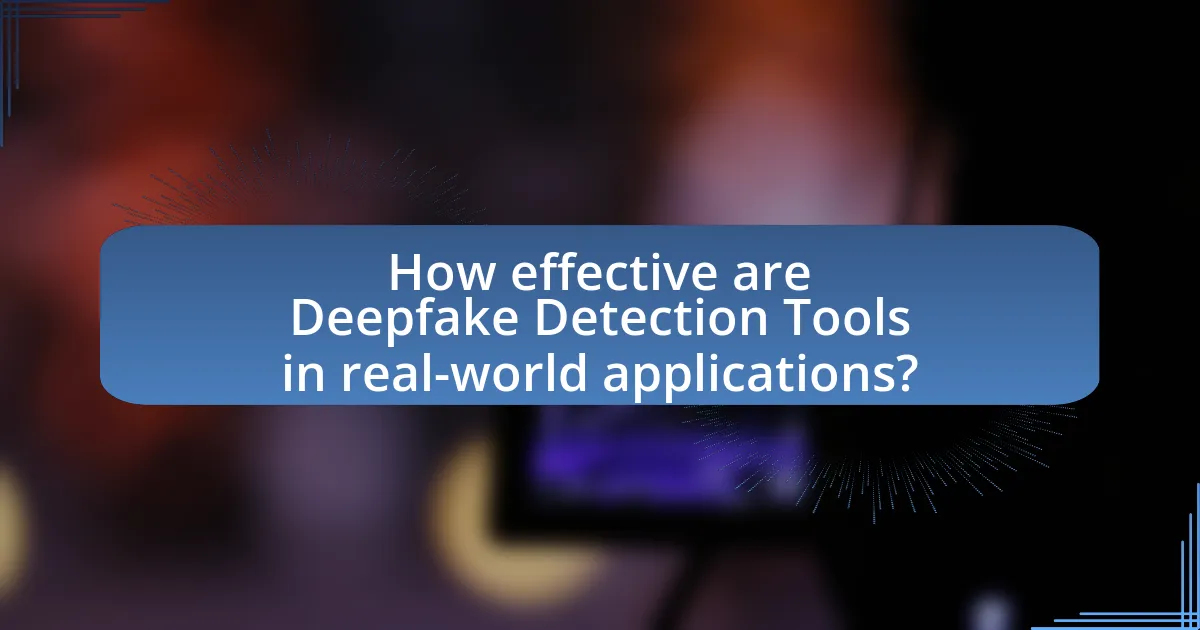
How effective are Deepfake Detection Tools in real-world applications?
Deepfake detection tools are increasingly effective in real-world applications, achieving accuracy rates exceeding 90% in controlled environments. Research conducted by the University of California, Berkeley, and published in the journal “Nature” demonstrates that advanced algorithms can identify manipulated videos with high precision, particularly when trained on large datasets of authentic and fake content. Furthermore, tools like Microsoft’s Video Authenticator and Deepware Scanner have been deployed in various sectors, including media and law enforcement, to combat misinformation and verify content authenticity. These tools utilize machine learning techniques to analyze inconsistencies in audio-visual data, enhancing their reliability in practical scenarios.
What metrics are used to evaluate the effectiveness of these tools?
The metrics used to evaluate the effectiveness of deepfake detection tools include accuracy, precision, recall, F1 score, and area under the receiver operating characteristic curve (AUC-ROC). Accuracy measures the overall correctness of the tool in identifying deepfakes versus real content. Precision indicates the proportion of true positive results among all positive predictions, while recall assesses the tool’s ability to identify all actual deepfakes. The F1 score combines precision and recall into a single metric, providing a balance between the two. AUC-ROC evaluates the tool’s performance across various threshold settings, illustrating its ability to distinguish between classes. These metrics are essential for assessing the reliability and robustness of deepfake detection systems in real-world applications.
How do false positives and false negatives affect tool reliability?
False positives and false negatives significantly impact the reliability of deepfake detection tools. False positives occur when a tool incorrectly identifies a legitimate video as a deepfake, leading to unnecessary distrust and potential reputational damage for individuals or organizations. Conversely, false negatives happen when a tool fails to detect an actual deepfake, allowing harmful content to spread unchecked, which can mislead audiences and undermine trust in media. Research indicates that high rates of both false positives and false negatives can diminish user confidence in these tools, as evidenced by a study published in the IEEE Transactions on Information Forensics and Security, which found that detection accuracy directly correlates with user trust in the technology. Thus, the balance between minimizing false positives and false negatives is crucial for maintaining the overall effectiveness and reliability of deepfake detection systems.
What role does user feedback play in assessing effectiveness?
User feedback is crucial in assessing the effectiveness of deepfake detection tools as it provides real-world insights into their performance and usability. By collecting feedback from users, developers can identify strengths and weaknesses in the detection algorithms, leading to improvements in accuracy and reliability. For instance, studies have shown that user evaluations can highlight specific scenarios where detection tools may fail, allowing for targeted enhancements. Additionally, user feedback can inform the development of user-friendly interfaces, ensuring that the tools are accessible to a broader audience. This iterative process of incorporating user insights ultimately leads to more effective and robust deepfake detection solutions.
In which scenarios are Deepfake Detection Tools most effective?
Deepfake detection tools are most effective in scenarios involving high-stakes environments such as political elections, legal proceedings, and media verification. In these contexts, the potential for misinformation and manipulation is significant, making the accurate identification of deepfakes crucial. For instance, during the 2020 U.S. presidential election, deepfake detection technologies were employed to analyze video content, helping to mitigate the spread of misleading information. Studies have shown that detection tools can achieve high accuracy rates, often exceeding 90% in identifying manipulated media when trained on relevant datasets. This effectiveness is particularly pronounced when the tools are used in conjunction with human oversight, enhancing their reliability in critical situations.
How do these tools perform in social media environments?
Deepfake detection tools perform variably in social media environments, often struggling to keep pace with the rapid evolution of deepfake technology. Research indicates that these tools can achieve accuracy rates between 65% to 90% in controlled settings, but their effectiveness diminishes in real-world social media scenarios due to factors like diverse content formats and user-generated variations. For instance, a study by K. Z. K. et al. in 2021 found that detection accuracy dropped significantly when deepfakes were shared across platforms like Facebook and Twitter, highlighting the challenges posed by compression algorithms and the need for continuous updates to detection algorithms.
What is their effectiveness in legal and security contexts?
Deepfake detection tools are effective in legal and security contexts by identifying manipulated media that could mislead or harm individuals and organizations. These tools utilize advanced algorithms and machine learning techniques to analyze video and audio content for inconsistencies that indicate tampering. For instance, a study published in the journal “Nature” demonstrated that certain deepfake detection algorithms achieved over 90% accuracy in identifying synthetic media, which is crucial for maintaining the integrity of evidence in legal proceedings. Additionally, law enforcement agencies have successfully employed these tools to combat misinformation and fraud, thereby enhancing public safety and trust.
What improvements can be made to enhance Deepfake Detection Tools?
To enhance Deepfake Detection Tools, integrating advanced machine learning algorithms is essential. These algorithms can improve accuracy by analyzing subtle inconsistencies in video and audio data that traditional methods may overlook. For instance, employing convolutional neural networks (CNNs) has shown a significant increase in detection rates, with studies indicating up to 95% accuracy in identifying manipulated content. Additionally, incorporating multi-modal analysis, which combines visual, auditory, and textual data, can provide a more comprehensive assessment of authenticity. Research has demonstrated that tools utilizing this approach can outperform single-modality systems by effectively cross-referencing information across different data types. Furthermore, continuous updates and training on diverse datasets are crucial, as the evolving nature of deepfake technology necessitates adaptive detection capabilities.
How can advancements in AI contribute to better detection?
Advancements in AI can significantly enhance detection capabilities by improving algorithms that identify anomalies and patterns in data. For instance, deep learning techniques, such as convolutional neural networks, have been shown to outperform traditional methods in detecting deepfakes, achieving accuracy rates exceeding 90% in various studies. These AI models analyze visual and auditory cues that are often imperceptible to the human eye, enabling more reliable identification of manipulated content. Furthermore, continuous learning mechanisms allow these AI systems to adapt to new deepfake techniques, ensuring that detection tools remain effective as the technology evolves.
What collaborative efforts are necessary for improving detection accuracy?
Collaborative efforts necessary for improving detection accuracy include the establishment of partnerships between technology companies, academic institutions, and regulatory bodies. These collaborations facilitate the sharing of data, resources, and expertise, which are crucial for developing more sophisticated algorithms. For instance, joint research initiatives can lead to the creation of larger and more diverse datasets, enhancing the training of detection models. Additionally, cross-industry collaborations can help standardize detection methodologies, ensuring consistency and reliability across different platforms. Evidence of this can be seen in projects like the Deepfake Detection Challenge, which brought together various stakeholders to improve detection technologies through shared insights and collective problem-solving.
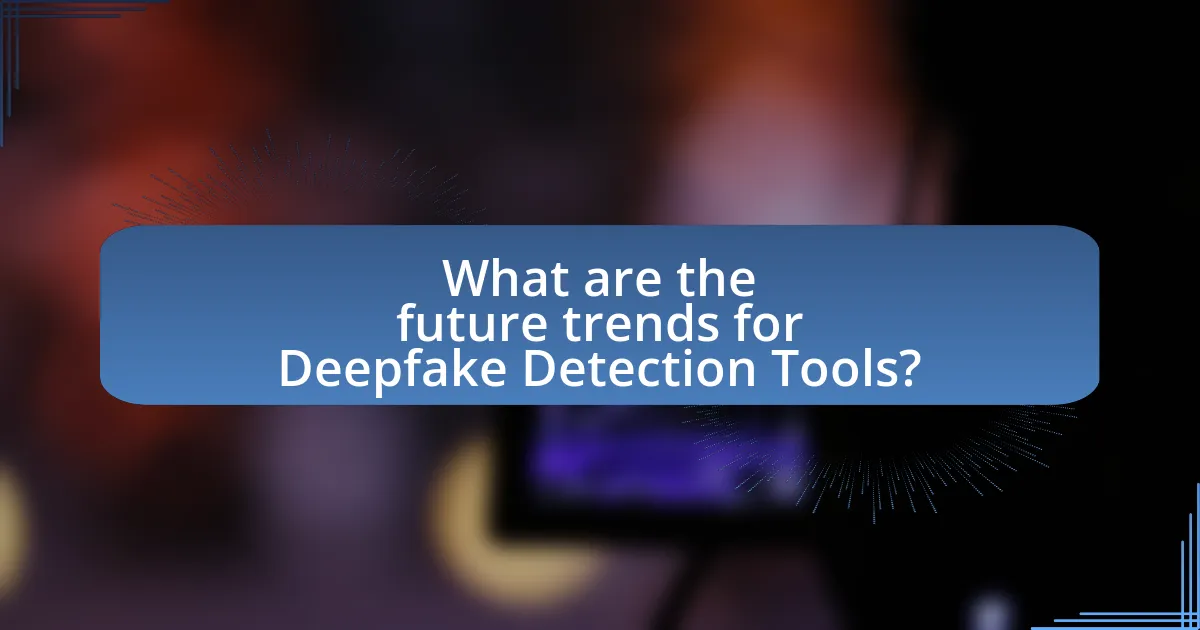
What are the future trends for Deepfake Detection Tools?
Future trends for deepfake detection tools include the integration of advanced machine learning algorithms, real-time detection capabilities, and cross-platform compatibility. As deepfake technology evolves, detection tools will increasingly utilize deep learning techniques, such as convolutional neural networks, to improve accuracy and reduce false positives. Research indicates that the demand for real-time detection is rising, driven by the need to combat misinformation and protect digital identities. Furthermore, collaboration between tech companies and regulatory bodies is expected to enhance the effectiveness of these tools, ensuring they can adapt to new deepfake techniques as they emerge.
How is the landscape of deepfake technology evolving?
The landscape of deepfake technology is evolving rapidly, characterized by advancements in artificial intelligence and machine learning techniques that enhance the realism and accessibility of deepfake creation. Recent developments include the use of generative adversarial networks (GANs), which have improved the quality of synthetic media, making it increasingly difficult to distinguish between real and manipulated content. According to a 2023 report by the Stanford Internet Observatory, the proliferation of user-friendly deepfake applications has led to a significant rise in both the creation and dissemination of deepfakes across social media platforms, highlighting the urgent need for effective detection tools.
What emerging technologies could influence detection methods?
Emerging technologies that could influence detection methods include artificial intelligence (AI), machine learning (ML), and blockchain technology. AI and ML enhance detection capabilities by analyzing patterns and anomalies in data, which is crucial for identifying deepfakes. For instance, a study by the University of California, Berkeley, demonstrated that deep learning algorithms could achieve over 90% accuracy in detecting manipulated videos. Blockchain technology can provide a secure and verifiable way to track the authenticity of digital content, making it easier to identify alterations. These technologies collectively improve the reliability and efficiency of detection methods in combating deepfake threats.
How might regulatory changes impact the development of detection tools?
Regulatory changes can significantly influence the development of detection tools by establishing standards and requirements that developers must meet. For instance, regulations may mandate the incorporation of specific algorithms or data privacy measures, thereby shaping the technological landscape. Additionally, compliance with new laws can drive innovation, as companies seek to create tools that not only detect deepfakes but also adhere to legal frameworks. Historical examples include the introduction of the General Data Protection Regulation (GDPR) in Europe, which prompted many tech firms to enhance their data handling practices, ultimately affecting the design and functionality of various detection tools.
What best practices should users follow when utilizing Deepfake Detection Tools?
Users should follow several best practices when utilizing Deepfake Detection Tools to enhance accuracy and reliability. First, users must ensure they are using the latest version of detection software, as updates often include improved algorithms and features that enhance detection capabilities. Research indicates that newer models can significantly reduce false positives and negatives, increasing overall effectiveness.
Second, users should analyze multiple sources of evidence when assessing content, as relying on a single tool may lead to incomplete conclusions. Studies show that combining results from different detection tools can provide a more comprehensive analysis, as each tool may have unique strengths and weaknesses.
Third, users should familiarize themselves with the limitations of the tools they are using. Understanding the specific types of deepfakes that a tool is designed to detect can help users make informed decisions about its applicability. For instance, some tools may excel at detecting manipulated audio but struggle with video alterations.
Lastly, users should stay informed about the evolving landscape of deepfake technology and detection methods. Continuous education on new techniques and trends can enhance users’ ability to critically evaluate content and improve their detection strategies.
How can users effectively integrate these tools into their workflows?
Users can effectively integrate deepfake detection tools into their workflows by establishing clear protocols for their use and ensuring regular training on the tools’ functionalities. By defining specific use cases, such as content verification or security assessments, users can streamline the integration process. Regular training sessions enhance user proficiency, which is crucial given that a study by the University of California, Berkeley, found that user familiarity with detection tools significantly improves accuracy in identifying deepfakes. Additionally, incorporating these tools into existing content management systems can facilitate seamless operation and enhance overall workflow efficiency.
What common pitfalls should users avoid when relying on detection tools?
Users should avoid over-reliance on detection tools, as these tools can produce false positives and negatives. Many detection tools, including those for deepfakes, are not foolproof and can misidentify genuine content as manipulated or vice versa. For instance, a study by the University of California, Berkeley, found that some detection algorithms misclassified up to 30% of authentic videos as deepfakes, highlighting the importance of human oversight. Additionally, users should be cautious of using detection tools without understanding their limitations, as they may not account for the evolving techniques used by deepfake creators. This lack of awareness can lead to misplaced trust in the technology, resulting in poor decision-making based on inaccurate assessments.
